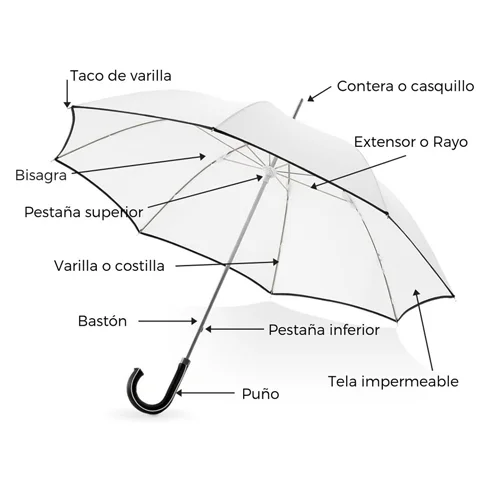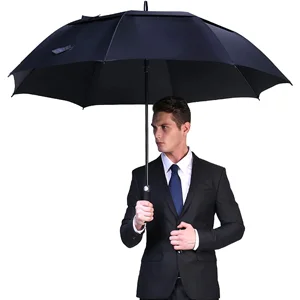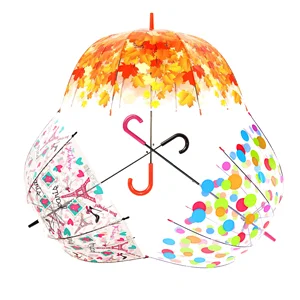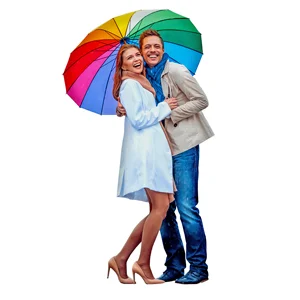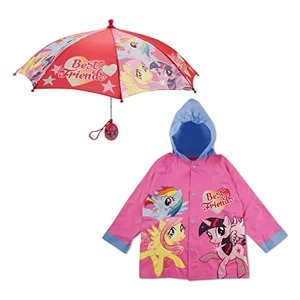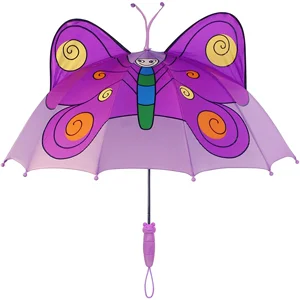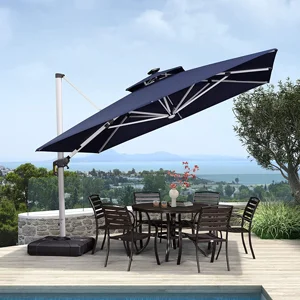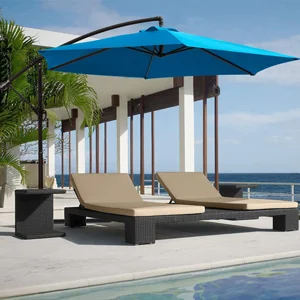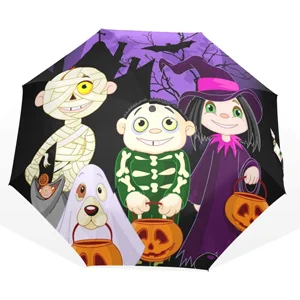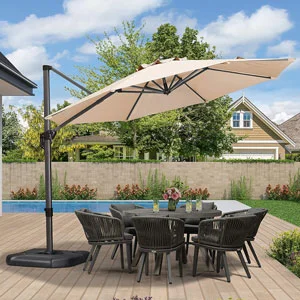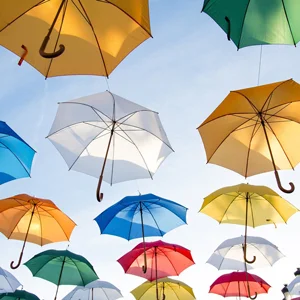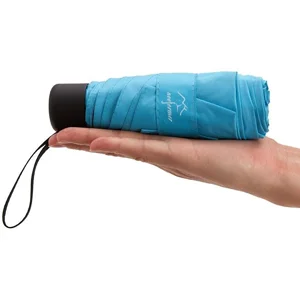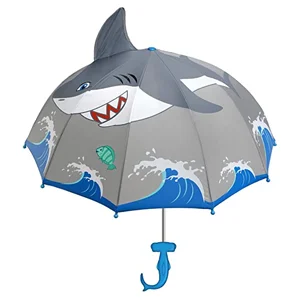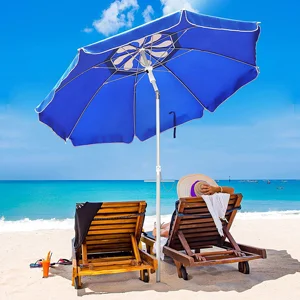¿De qué materiales están hechas las sombrillas y cuáles son sus partes?
Básicamente las sombrillas están hechas de varios materiales, y eso responde a que están formada por diferentes partes que la componen y que tienen una función específica.
Cada parte debe tener el material adecuado para un rendimiento óptimo en su funcionalidad, esto tiene mucho que ver con flexibilidad, dureza, desgaste por fricción, ligereza, resistencia e impermeabilidad.
¿Cuáles son las partes de la sobrilla y cómo se llaman?
Las sombrillas o paraguas están formados esencialmente por tres partes: Montura o Varillaje, Tela, y Puño o Mango.
Sin embargo, para ser más precisos debemos entrar en más detalles, de esta forma podemos dividir estas tres partes en muchas más, dándonos una idea más clara de los elementos que la conforman.
En la siguiente imagen podemos ver claramente cada una de estas partes: Contera o casquillo, Taco de varilla, Extensor o Rayo, Bisagra, Pestaña superior, Pestaña inferior, Varilla o Costilla, Bastón.
¿De qué materiales están hechas las sombrillas, y cuales son las funciones de sus partes?
A continuación, verá los materiales más usados en la confección de las sombrillas, aunque, con el desarrollo tecnológico, muchos otros materiales se van insertando en el este proceso de diseño y creación.
Esto responde a intereses muy marcados en disminuir su peso, aumentar su durabilidad, mejorar la protección UV, garantizar la impermeabilidad y, sobre todo, satisfacer las necesidades del que compra la sombrilla.
1.- Contera o Casquillo: Metal o Plástico.
Se refiere a la parte que se encuentra en la parte superior del marco y que sirve como soporte para la tela.
2.- Taco de Varilla: Madera, Metal o Plástico.
Sujeta la tela de la sombrilla en los extremos de la varilla o el marco. Es un componente importante que ayuda a mantener la tela estirada y a prevenir que se arrugue o se desgaste prematuramente.
3.- Extensor o Rayo: Metal, Madera o Plástico.
Es un componente que se encuentra en la parte inferior de la tela y que se extiende desde la varilla o el marco hasta la periferia de la tela. El extensor o rayo es un componente importante que ayuda a mantener la tela estirada y a proporcionar una mayor superficie de sombra.
4.- Bastón: Metal, Madera o Plástico.
Su función es sostener la sombrilla y toda la estructura que la forma. Es la parte que se agarra para mover o posicionar la sombrilla.
5.- Puño: Metal, Madera o Plástico y algunos otros materiales antideslizantes para lograr mejor agarre.
El puño es la parte por donde regularmente agarramos la sombrilla, puede tener diferentes formas y tamaños.
6.- Tela: Algodón, Poliéster y una gran variedad de materiales, puede ser impermeable, pero no necesariamente.
La tela de una sombrilla es el componente que proporciona sombra y protección. Es un componente clave en la capacidad de la sombrilla para cumplir su función y su apariencia.
7.- Bisagra: Metal, Madera o Plástico.
Permite que la sombrilla se abra y se cierre de manera suave y controlada. La bisagra une el Extensor o Rayo y la Varilla o Costilla.
8.- Pestaña superior: Metal, Madera o Plástico.
Pieza que mantiene la sombrilla abierta.
9.- Pestaña inferior: Metal, Madera o Plástico.
Pieza que mantiene la sombrilla cerrada.
10.- Varilla o Costilla: Metal, Madera o Plástico.
Es la parte que se encarga de sostener la tela en su lugar. La varilla es un componente crítico en la estructura de una sombrilla, y está diseñada para permitir que la sombrilla se abra y se cierre.
Estos son las parte y algunos de los materiales con que se fabrican la mayoría, sin embargo, esto depende del uso para el que está diseñada. Por esta razón es de gran importancia saber cómo será usada.
Sombrillas teniendo en cuenta los materiales.
Es importante señalar que, debido a la diversidad de materiales, es vital saber de que material está hecha una sombrilla, y así de esta forma saber si nos será útil o no.
Estructura principal de metal, madera, plástico o materiales ligeros y resistentes.
El uso de estos materiales está enfocados al destino final, ejemplo:
Las sombrillas con estructura de materiales ligeros se emplean en sobrillas que usamos frecuentemente y que debemos llevar con nosotros.
Las de estructura de madera están más dirigidas a sombrillas para exteriores (terrazas, patios, piscinas, o playa) con el objetivo de encontrar armonía con los muebles de patio, esto es válido para sombrillas con estructuras de metal, también para garantizar la integridad de la sombrilla frente a inclemencias del tiempo.
Estructuras de plástico son menos resistentes y son más usadas en juguetes para niños y niñas y en sombrillas que no requieren de grandes prestaciones. Son ligeras y fácil de usar.
Tela o Cubierta de Poliéster, Algodón, Paja, Papel, o con Protección Ultravioleta.
Las sombrillas con cubierta de poliéster o algodón se usan básicamente para protegernos de la luz del sol, ya sea con o sin protección UV, pueden ser impermeables o no.
Las cubiertas de paja son excelentes protectoras de la luz solar y de la lluvia, estas se usan con frecuencias en sombrillas de playa, en terrazas y piscinas, y brindan un ambiente muy natural, se usan con un fin decorativo y de protección.
Una cubierta de papel o material similar, no es más que una sombrilla desechable, esto significa que son usadas con propósitos decorativos a corto plazo y las podemos ver en la decoración de coctelería en bares y restaurantes. También en otras decoraciones a más largo plazo como pueden ser espacios interiores donde su utilidad es visual y no esta relacionada con el concepto propio para el que están creadas las sombrillas.
¿Cómo es el proceso de elaboración de un paraguas?
El proceso de elaboración de un paraguas implica varias etapas, desde el diseño hasta el ensamblaje final. A continuación, se describe de manera general el proceso de fabricación de un paraguas:
- Diseño: Se realiza el diseño del paraguas teniendo en cuenta aspectos como el tamaño, la forma, el número de paneles, el mecanismo de apertura y cierre, y el tipo de mango. También se decide el tipo de tela y los colores a utilizar.
- Corte de tela: Se cortan los paneles de tela según el diseño elegido. Los paneles suelen tener forma triangular o rectangular, y se cortan en múltiples capas para mejorar la resistencia y durabilidad del paraguas.
- Costura: Se procede a coser los paneles de tela juntos, generalmente utilizando máquinas de coser especializadas. Durante este proceso, también se pueden agregar ribetes u otros detalles decorativos.
- Armazón y varillas: Se fabrica el armazón del paraguas, que consta de un eje central, varillas y puntales. Estos elementos se suelen hacer de materiales como acero, aluminio o fibra de vidrio, que ofrecen resistencia y flexibilidad.
- Montaje: Las varillas se insertan en los paneles de tela cosidos previamente. El extremo de cada varilla se sujeta al armazón y se fija en su lugar.
- Mecanismo de apertura: Dependiendo del tipo de paraguas, se instala el mecanismo de apertura y cierre. Puede ser un sistema manual con una correa o un botón, o un mecanismo automático que se activa mediante un botón.
- Mango: Se agrega el mango en el extremo del eje central para facilitar el agarre y el manejo del paraguas. Los mangos pueden ser de plástico, madera, metal u otros materiales.
- Acabado final: Se revisa y ajusta el paraguas para garantizar su funcionamiento correcto. Se pueden hacer modificaciones menores y se verifica que todos los componentes estén en su lugar.
- Pruebas de calidad: Se realizan pruebas de calidad para asegurarse de que el paraguas cumpla con los estándares de resistencia al viento, impermeabilidad y durabilidad. Estas pruebas pueden incluir pruebas de apertura y cierre repetido, resistencia al viento y resistencia al agua.
- Embalaje: Finalmente, los paraguas se empaquetan y etiquetan para su distribución y venta.
Es importante destacar que el proceso de elaboración puede variar según el fabricante y el tipo de paraguas. Algunos paraguas más especializados, como los paraguas plegables o los paraguas de golf, pueden requerir pasos adicionales o características específicas.
Conclusiones.
Seguramente ahora tienes una idea más clara del nivel de detalles que componen una sombrilla estándar y algunos de sus usos de acuerdo con los materiales empleados para fabricarlas. Además de la precisión con que deben ajustarse y funcionar sus partes para que funcione correctamente.
Preguntas frecuentes.
La cantidad de rayos en un paraguas puede variar dependiendo del diseño y el tamaño del paraguas en particular. Los paraguas más comunes suelen tener entre 8 y 10 rayos, que se extienden desde el eje central hasta los bordes del paraguas. Estos rayos se despliegan al abrir el paraguas y se encargan de sostener la estructura de la tela. Sin embargo, existen paraguas de diferentes tamaños y estilos, algunos con menos rayos o con más para brindar una mayor resistencia al viento. En general, la cantidad de rayos en un paraguas está diseñada para equilibrar la estabilidad y la funcionalidad del paraguas en diversas condiciones climáticas.
En sus inicios, Alemania lideraba la producción de paraguas, pero posteriormente Japón asumió el control en la década de 1970. Más adelante, la producción se trasladó a Taiwán en la década de 1980, hasta que finalmente China se convirtió en el principal actor del mercado desde la década de 1990 hasta la actualidad. En la actualidad, la mayor parte de los paraguas fabricados y exportados a nivel mundial provienen de China.
Es importante destacar que la fabricación de paraguas se ha vuelto una industria globalizada, con diferentes países especializados en distintos aspectos del proceso de producción, como el diseño, la fabricación de armazones o la confección de la tela. Por lo tanto, no todos los paraguas provienen exclusivamente de China, sino que se fabrican en diferentes partes del mundo para satisfacer la demanda global.
Tener todo esto en cuneta ayudara a escoger la que nos sea 100% efectiva.
Esperamos que le haya sido útil este breve resumen sobre las partes y materiales de las sombrillas 👍





